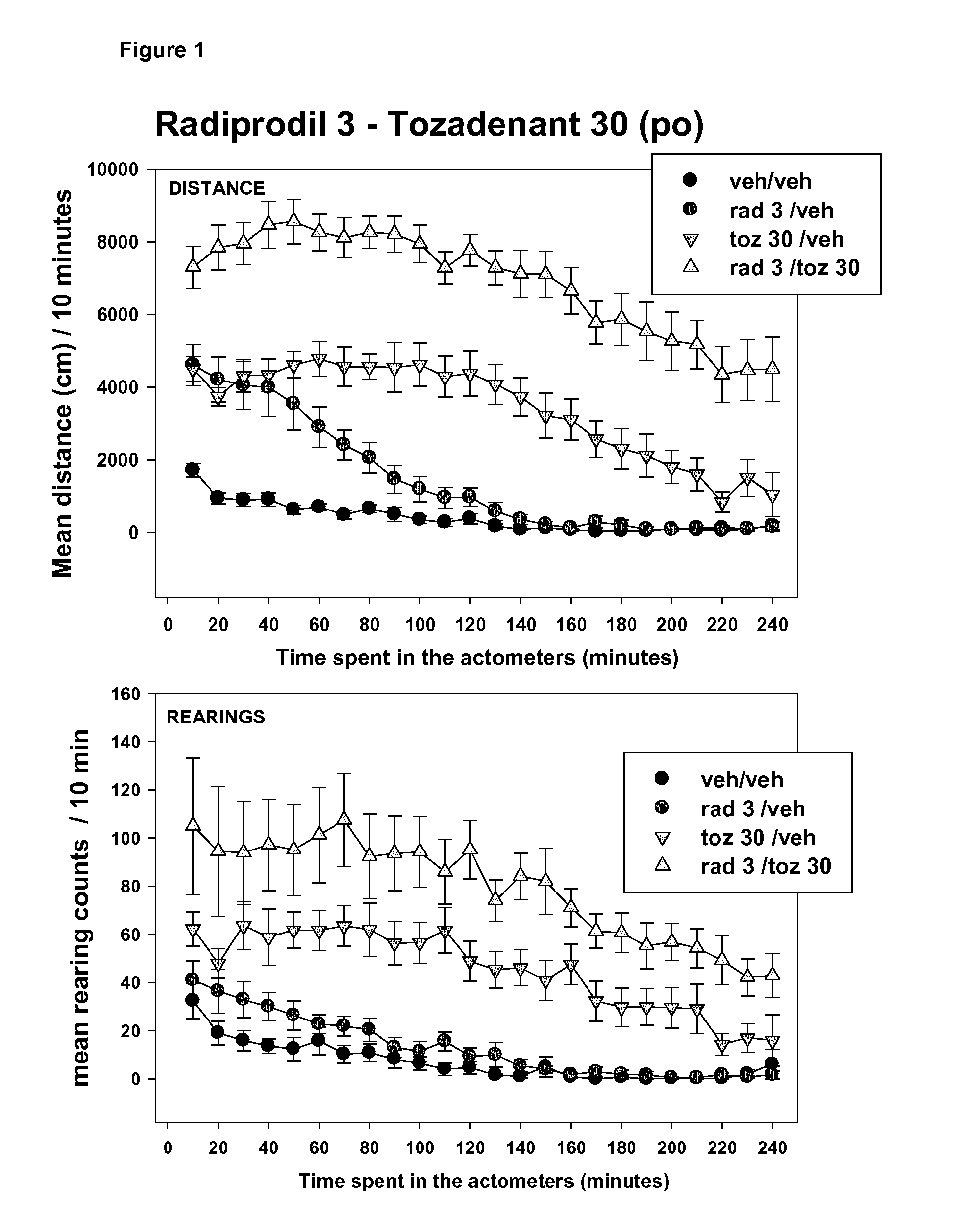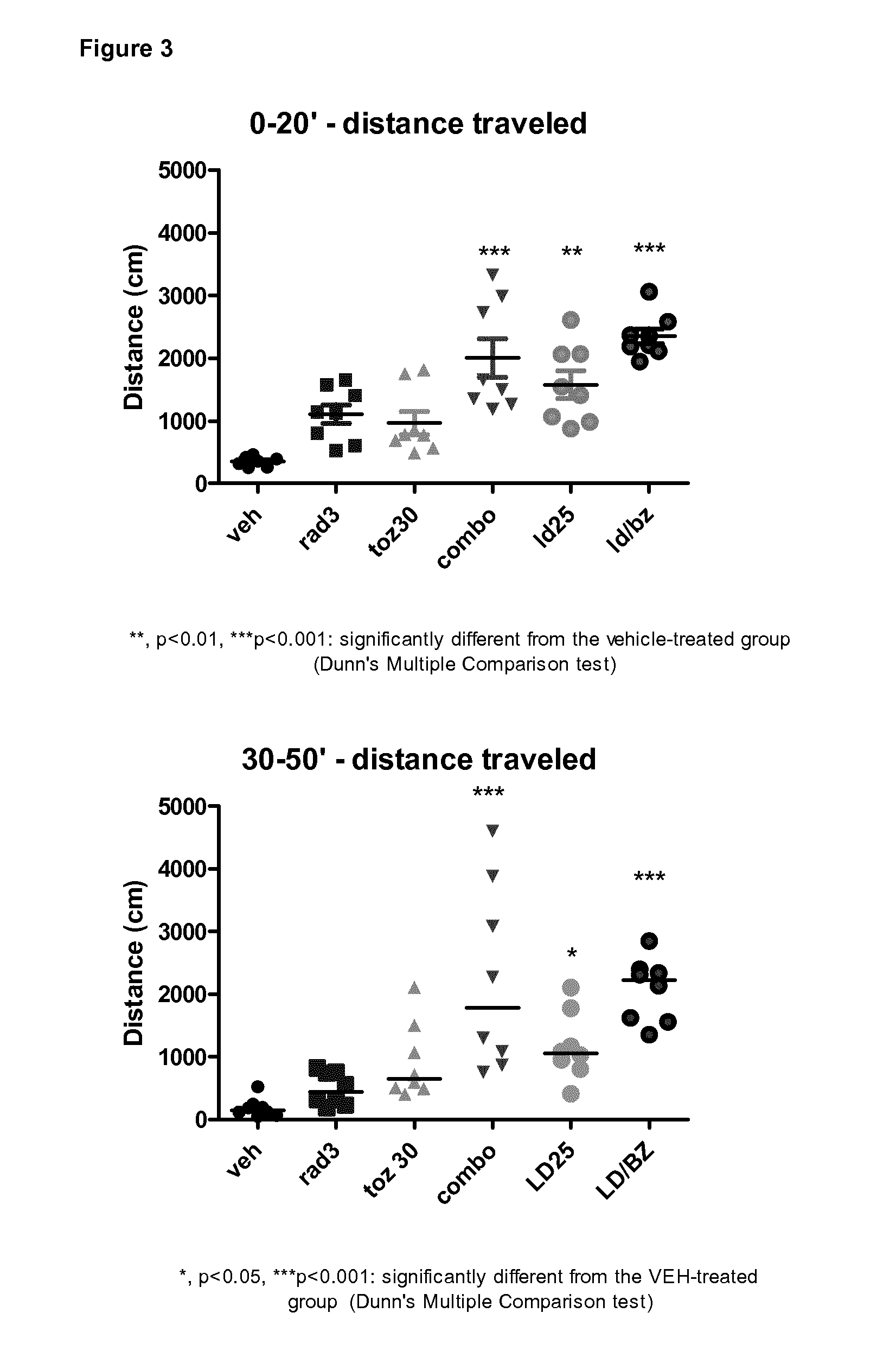Methods for treating Parkinson's disease
a parkinson's disease and treatment method technology, applied in the field of parkinson's disease treatment methods, can solve problems such as cognitive and behavioural problems, satisfactory treatment, and imbalance in the neuronal circui
- Summary
- Abstract
- Description
- Claims
- Application Information
AI Technical Summary
Benefits of technology
Problems solved by technology
Method used
Image
Examples
example 1
Efficacy of the Combination of an A2A Antagonist Together with an NR2B Antagonist on the Quantity of Activity Across Six Different Embodiments
[0175]Six different co-administrations of an A2A antagonist together with an NR2B antagonist (=COMBO) are tested in the unilateral 6-OHDA-lesioned rat model of Parkinson's disease according to TABLE 1.
[0176]The behavioural parameters recorded were “distance travelled” and “rearing counts”. These latter are automatically measured in actometers. All of the co-administrations show significant increases in the level of activity (distance and / or rearing counts) in comparison to the treatment done with the compounds alone.
[0177]
TABLE 1NR2B ANTAGONISTCo-101244Compound 1RadiprodilA2AKW-6002+ANTAGONISTSCH-58261++Preladenant++Tozadenant++: A2A / NR2B combination tested and activity for distance and / or rearing is superior to the testing of the compounds alone
[0178]In every combination (combo), the added-value of such treatment on the hemi-parkinsonian rat ...
example 2
Demonstration of the Efficacy of the Combination on the Quality of the Stimulated Motor Activity with One Specific Example (Tozadenant and Radiprodil)
[0179]The co-administration of an NR2B antagonist and an A2A antagonist has shown across 6 different combos an unexpected increase of the level of activity (distance travelled and rearing counts). This unexpected behavioural profile (i.e. increase motor activity with excellent body position) that was observed visually while the animals were placed in the activity chambers (actometers) is described, in detail, in the subsequent example and illustrated by the quantitative measurement of various behavioural parameters.
[0180]The effects of the oral co-administration of Radiprodil (3 mg / kg, po) with Tozadenant (30 mg / kg, po) on the rat behaviour are compared to the testing of:[0181]1) these compounds separately[0182]2) a partially active dose of L-Dopa (25 mg / kg, ip)[0183]3) a fully active dose of L-Dopa / benserazide (16 / 4 mg / kg, ip).
[0184]T...
example 3
Efficacy of the Combined Administration of “Tozadenant+Radiprodil” on Motor Symptoms without the Development of any Abnormal Movements after Chronic Treatment
[0202]Chronic treatment for 10 days with the combo does not lead to the development of any abnormal motor complications as is observed with L-Dopa. The rats remain active even if some habituation process develop to the testing arena. Despite this normal phenomenon, the significant effect of the combo on the level of activity and on the quality of the movement is still observed.
PUM
| Property | Measurement | Unit |
|---|---|---|
| humidity | aaaaa | aaaaa |
| temperature | aaaaa | aaaaa |
| volume | aaaaa | aaaaa |
Abstract
Description
Claims
Application Information
 Login to View More
Login to View More - R&D
- Intellectual Property
- Life Sciences
- Materials
- Tech Scout
- Unparalleled Data Quality
- Higher Quality Content
- 60% Fewer Hallucinations
Browse by: Latest US Patents, China's latest patents, Technical Efficacy Thesaurus, Application Domain, Technology Topic, Popular Technical Reports.
© 2025 PatSnap. All rights reserved.Legal|Privacy policy|Modern Slavery Act Transparency Statement|Sitemap|About US| Contact US: help@patsnap.com



